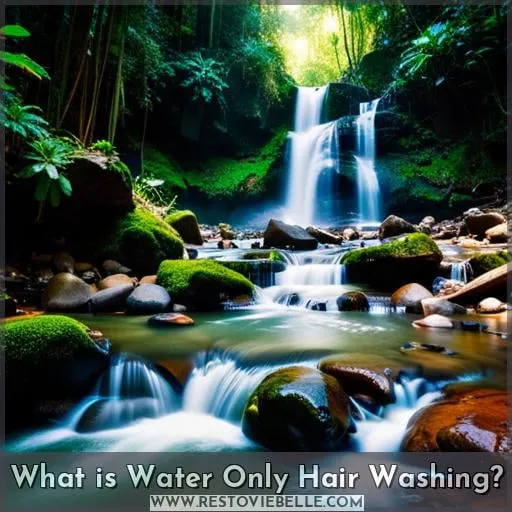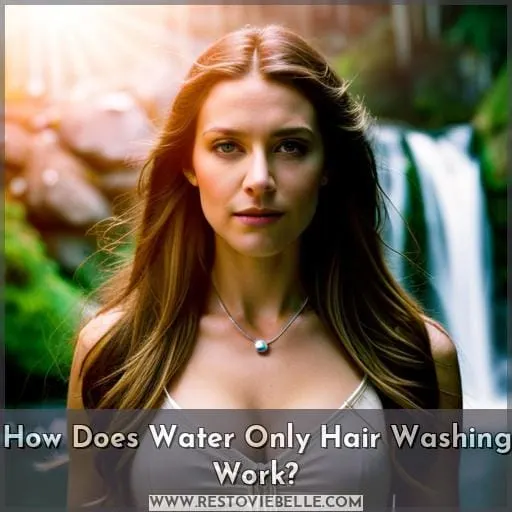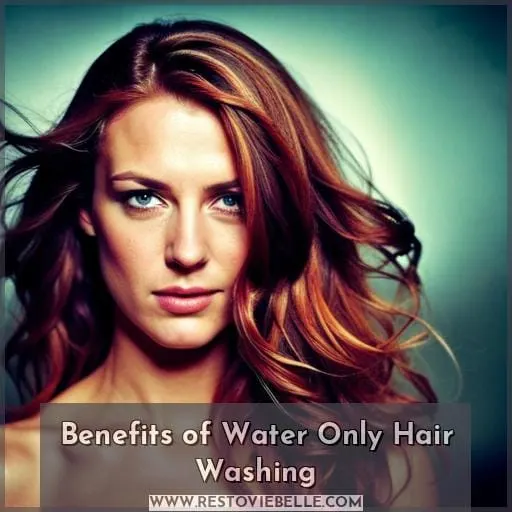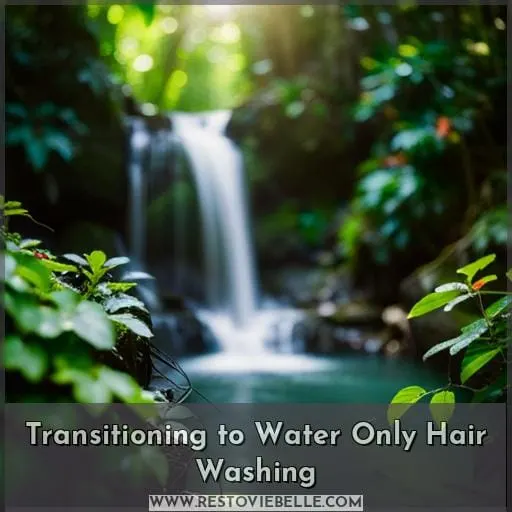This site is supported by our readers. We may earn a commission, at no cost to you, if you purchase through links.
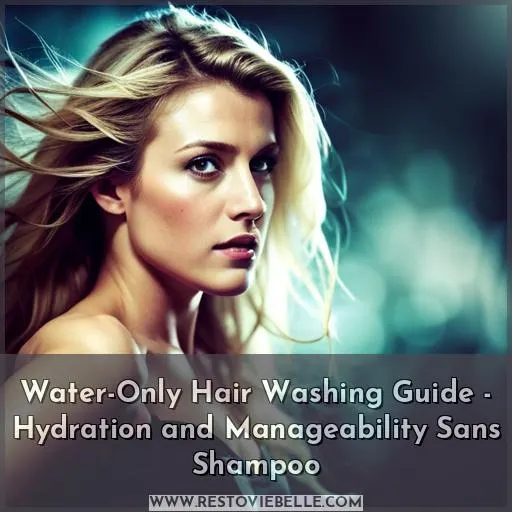 You used to think that washing hair meant a bottle of shampoo; now you know that a bottle of water does the trick. Water-only washing frees your hair and scalp from chemical dependence. With this simple shift, your natural oils can balance, leaving hair clean, shiny, and hydrated.
You used to think that washing hair meant a bottle of shampoo; now you know that a bottle of water does the trick. Water-only washing frees your hair and scalp from chemical dependence. With this simple shift, your natural oils can balance, leaving hair clean, shiny, and hydrated.
Just a splash of H2O lets your locks’ true beauty flow. Of course, transitioning takes time. But once you’re there, you’ll feel a sense of hair freedom like never before. Water gives life – to plants, animals, and yes, your hair.
Table Of Contents
- Key Takeaways
- What is Water Only Hair Washing?
- How Does Water Only Hair Washing Work?
- Benefits of Water Only Hair Washing
- Transitioning to Water Only Hair Washing
- Tips for Different Hair Types
- Troubleshooting Water Only Hair Washing
- Frequently Asked Questions (FAQs)
- How often should I wash my hair with just water? The ideal frequency depends on your hair type and lifestyle. For oily hair, every 2-3 days may work best. For dry hair, spacing out washes to 4-7 days allows natural oils to spread. Adjust as needed.
- Will water washing work for color treated hair? It can, though color treated hair may require more frequent washing. Ensure hair is properly moisturized to avoid color fading. Touch up roots as needed.
- Conclusion
Key Takeaways
- Eliminates need for shampoo and conditioner, allowing hair’s natural oils to nourish.
- Requires a transition period to adjust technique and reduce shampoo use over time.
- Preparation like preening, scritching, and using a boar bristle brush is essential.
- Frequency depends on hair type; solutions like an apple cider vinegar rinse can help with challenges.
What is Water Only Hair Washing?
Looking for a healthier, more natural way to care for your hair? Water-only hair washing relies on your scalp’s natural oils to nourish strands, eliminating harsh chemicals that can dry and damage hair.
Spreading oils from root to tip creates soft, shiny hair without the need for shampoos or conditioners that disrupt your hair’s natural pH balance.
Chemical-Free Haircare
You can bid farewell to severe chemicals and greet natural nourishment with this chemical-free tactic.
- Spurs hair’s inherent sebum yield
- Sanctions scalp to self-direct and poise
- Wipes out exposure to harmful elements
- Nourishes strands with innate oils
- Restores hair’s pH equilibrium gently
Water-only washing sanctions your hair to boom in its purest form. By extracting harsh detergents, you permit your scalp and strands to self-provide. Devoid of interference from withering sulfates and alcohols, your hair can manage its innate moisture and oil heights.
Your curls will spring back to vitality, free of accumulation. Go green and sanction your inner beauty to gleam through, with this chemical-free avenue to fit, saturated hair.
Natural Oil Distribution
By coincidence, natural oil distribution helps transition away from shampoos.
When washing hair with only water, sebum can spread from the roots along the length of the hair shafts. This allows for more even distribution compared to the removal of oils by surfactants in shampoos.
As the scalp adjusts and produces less oil, natural shine and texture improve. Over time, this boosts scalp health and reduces hair maintenance.
| Oily Hair | Normal Hair | Dry Hair | |
|---|---|---|---|
| First Month | Extra greasy | Longer adjustment | Potentially straw-like until transition complete |
| After Adjustment | More balanced | Soft and manageable | Increased hydration and shine |
| Long Term | Less oil needed for shine | Ideal natural oil levels | Condition greatly improved |
Relying on the body’s natural oils takes patience but pays off with long-term scalp and hair health. Gradually reducing harsh shampoos allows hair to reach its ideal balance. Transitioning requires adjusting to changes in oil production over several weeks.
With time, each hair type sees improvements in texture, shine, and overall condition from restored natural oil distribution.
How Does Water Only Hair Washing Work?
You’ll want to start your water-only hair washing routine with some simple pre-shower techniques. Use a boar bristle brush for scritching and preening to spread oils. Then, rinse hair upside down in cool water before air drying or gently patting with a microfiber towel.
Pre-Shower Techniques
Scratch and preen your locks thoroughly to spread oils before showering. Start by scritching your scalp with blunt nails to lift dirt and distribute natural oils. Use your fingertips in small circular motions all over. Next, preen the length of your hair to coat strands in sebum.
Grasp sections near the roots and glide downwards. Brush through gently with a natural bristle brush afterward. Those with straight hair may need extra scritching for adequate oil transfer. Curly and coily hair benefits from wide-tooth combing to pre-distribute oils.
Proper pre-shower prep allows water-only washing to work optimally. It lets your hair’s natural oils moisturize and nourish.
Rinsing and Drying Tips
Rinse with cool water before gently plopping hair in a towel to sop up excess moisture, then let air dry the rest of the way for maximized volume and shine. After water-only washing, it’s crucial to finish with a cold rinse, as this helps close cuticles for sleeker strands.
For curly hair, scrunch in a leave-in conditioner or curl cream post-shower to enhance definition.
Blotting with a microfiber towel prevents frizz before air drying. Hard water can leave mineral residue, so a vinegar or lemon rinse helps restore balance. With some practice, water-only washing leaves hair bouncy and beautiful without all the froufrou products.
Benefits of Water Only Hair Washing
You will find that natural moisture, volume, softness, and manageability are the biggest benefits of water-only hair washing. After ditching shampoo, the natural oils in your hair and scalp are restored, leaving hair silky soft, bouncy, yet manageable with less frizz and a reduced need for styling products.
Hydration and Volume
You’ll notice lustrous locks with just water alone. Hydrating your hair this way brings out its natural beauty.
- Massage your scalp to spread oils
- Rinse hair upside down for volume
- Use cool water to lock in moisture
Embracing water-only washing keeps hair hydrated and voluminous. The natural oils condition strands while cool rinses seal in moisture. Massaging the scalp ensures oils reach all hair evenly. Rinsing upside down adds body.
Your locks will feel soft, shiny and full of life with this simple, eco-friendly method.
Softness and Manageability
Long gone are weighed-down strands since you’ve embraced water-only washing’s softening benefits.
| Manageability | Softness | Less Frizz |
|---|---|---|
| Detangling ease | Silky feel | Softer curls |
| Flexible styling | Smooth texture | Reduced puffiness |
| Less tangles | Shine | Bouncier waves |
By ditching harsh shampoos and embracing your natural sebum, your hair’s never felt softer or been easier to style. The water-only method allows your natural oils to spread evenly from root to tip, leaving hair silky smooth with plenty of shine.
Say goodbye to frizz and enjoy hair that feels touchably soft. Whether you prefer to let curls air dry or style waves into smooth formation, your tresses will glide into place with less resistance.
Transitioning to Water Only Hair Washing
You’re ready to make the switch to water-only hair washing. Begin by gradually reducing shampoo use over a few weeks to allow your scalp and strands time to adjust to producing their own natural oils. Without the stripping effects of shampoo, you’ll start to see improved moisture, softness, and manageability as your hair transitions out of the shampoo cycle.
Reduce Shampoo Use
As the chemicals fade, you’ll find less need for shampoo.
- Test wash cycles of 1-3 days without shampoo. See how your hair responds.
- Use a boar bristle brush before showering to distribute oils.
- Alternate with an apple cider vinegar rinse for a weekly reset.
- Look into natural no-poo cleansers if desired.
- Consider deep conditioning treatments for moisture.
Transition gradually and listen to your hair. With less product buildup, natural sebum and texture emerge. Rediscover the beauty of your hair’s natural rhythm. This sustainable path leads to freedom from daily shampooing.
Adjustment Period
Manage the marathon months mastering moisture methods minimizing matted messes. During the challenging adjustment duration, expect the excess sebum secretion. Do not despair, darling! This transitional phase will pass as your hair adapts to the water-only routine.
Massage your scalp to evenly distribute oils. Use a boar bristle brush pre-wash for optimal oil migration reducing matts. For optimal volume, blast roots with cool air upside down post-wash. We recommend acidifying rinses to eliminate stubborn buildup and nourish locks.
You can do this! Consistency conquers the adjustment phase transforming your tresses into stronger, shinier strands! Through holistic techniques and dedication to this sustainable haircare method, luscious locks await.
Tips for Different Hair Types
Let’s get right to it. As someone with curly hair looking to transition to water-only washing, you may face some unique challenges. Using specific techniques to evenly distribute your natural oils can help control frizz and enhance your curls’ natural pattern.
Pay close attention to properly scrunching, preening, and air drying to maximize volume and definition. With time, patience, and consistency, your coils will adjust to this chemical-free routine for healthy, nourished locks.
Curly Hair
You’ve got this, curly girl! Embracing your natural texture is the first step. Water-only washing helps your curls thrive by preserving moisture and natural oils. Start by distributing sebum from your scalp to your ends with scritching and preening before each wash.
Focus the water stream on your roots when rinsing, so curls don’t get overwashed. For extra frizz control, finish with a cold water blast. When air drying, avoid touching or scrunching wet hair. If needed, add a pea-sized amount of natural curl cream to parched ends. With some practice, you’ll find the right balance for your waves and coils.
Oily or Dry Hair
Stick with it, ’cause soon the sebum balance will shift in your favor. I know the struggle, my oily-haired friend. During the transition, your scalp works overtime trying to hydrate those dry, thirsty strands.
Be patient – this too shall pass. Focus on gently massaging to evenly distribute oils from root to tip.
Don’t despair, my dry-haired darling! As sebum production normalizes, your hair will balance its own oils. Nourish parched locks with weekly deep conditioning treatments. And take heart – increased volume and natural shine are just around the corner once your hair finds its equilibrium.
Troubleshooting Water Only Hair Washing
As an experienced trichologist, I want to address two common issues that arise with water-only hair washing right away – hard water and frizz/hair fall. We’ll explore acidic rinses that help with hard water mineral buildup and techniques to distribute natural oils from your scalp to hydrate, minimize frizz, and reduce hair loss.
Hard Water Solutions
While livin’ la vida loca without shampoo, soften that hard water to keep locks luscious. Hard water wreaks havoc on hair, leading to dryness, frizz, and mineral buildup. Invest in a shower head filter to remove calcium and magnesium. Alternatively, fill a spray bottle with distilled water and spritz hair before rinsing out conditioner.
For a DIY approach, try an apple cider vinegar rinse – the acidity fights limescale. Style as usual with leave-ins to prevent brittle strands. Most importantly, deep condition regularly to restore softness and shine.
Skipping shampoo doesn’t have to be traumatic for your tresses if you counteract hard water properly.
Frizz and Hair Fall
Don’t fret about frizz and hair fall problems; there’re some tricks that can help combat them.
- Use a boar bristle brush to spread oils from your scalp to ends.
- Gently scrunch in leave-in conditioner for extra hydration.
- Try protective styling like braids or use a silk pillowcase.
- Monitor your diet and nutrients that support healthy hair growth.
Trust your hair’s natural process. With some TLC, your hair will find its balance on the water-only path.
Frequently Asked Questions (FAQs)
How often should I wash my hair with just water? The ideal frequency depends on your hair type and lifestyle. For oily hair, every 2-3 days may work best. For dry hair, spacing out washes to 4-7 days allows natural oils to spread. Adjust as needed.
You simply wash when it feels right. Listen to your hair’s natural rhythm. Let it guide when grime or grease says it’s time to freshen up. But resist over-washing, as that strips away the oils that nourish and protect. Find your hair’s happy balance.
Will water washing work for color treated hair? It can, though color treated hair may require more frequent washing. Ensure hair is properly moisturized to avoid color fading. Touch up roots as needed.
You can still water wash color-treated hair – just increase the frequency to every 2-3 days. The key is keeping hair moisturized and roots touched up regularly to prevent fading.
Conclusion
Right off the bat, transitioning to water-only hair washing is a breeze with proper preparation and managed expectations. This back-to-basics approach allows your tresses to thrive without shampoo while reaping hydration, softness, volume, and ease of styling – water-only hair washing simplifies haircare.
Adjusting techniques for your hair type and troubleshooting any issues ensures lush, manageable locks. Give water-only washing a try and let your crowning glory flourish chemical-free. Sebum and scrubbing stimulate the scalp for hair that’s primed to dazzle with minimal effort.

